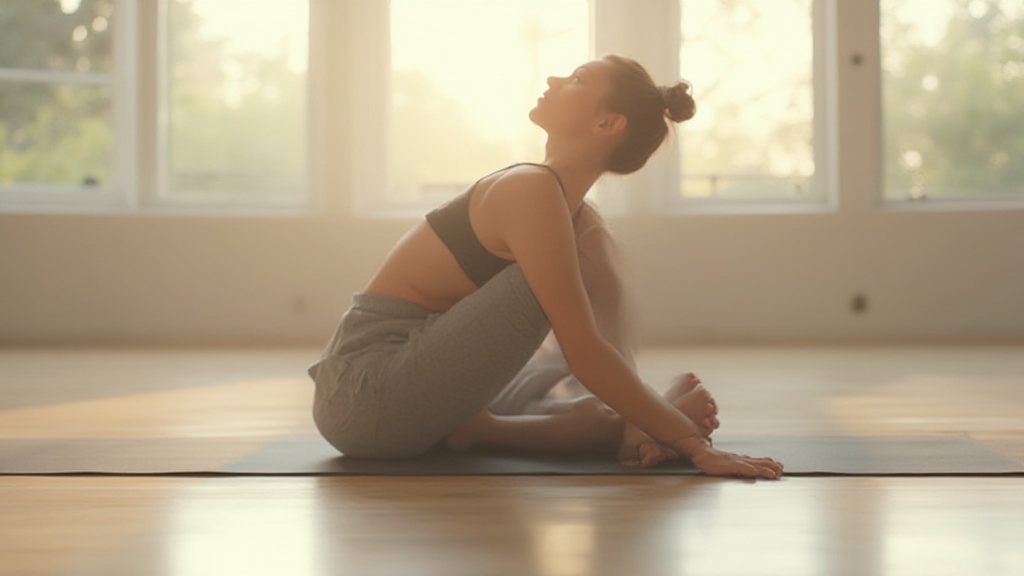
Achieving optimal hamstring flexibility plays a significant role in enhancing overall fitness and athletic performance. Many individuals, including both active athletes and those who lead sedentary lifestyles, often experience tight hamstrings.
This common condition requires effective stretching routines that can improve flexibility and alleviate discomfort.
This article will outline the best stretches for hamstrings, detailing their advantages, and demonstrating how the consistent incorporation of these stretches into your routine can result in substantial improvements in physical well-being.
Understanding Hamstring Flexibility Benefits
Enhancing hamstring flexibility is essential for maximizing athletic performance.
Increased flexibility facilitates a greater range of motion, which is directly linked to improved speed and agility during activities such as running and jumping. A flexible hamstring is also integral to overall lower body strength, thereby supporting various movements across different sports.
Better flexibility leads to reduced muscle tightness, consequently lowering the risk of injuries. These stretches are indispensable for implementing effective injury prevention techniques in athletic training.
Regularly incorporating hamstring stretches into a fitness regimen can yield long-term benefits in both athletic performance and overall health.

Effective Stretching Routine Explained
An effective stretching routine can greatly enhance overall fitness performance. A comprehensive stretching routine includes both dynamic stretches and static stretches, which work together to improve mobility and reduce injury risk.
Begin with dynamic stretches, such as leg swings and walking lunges, to effectively warm up your muscles.
Transition into static stretches like seated toe touches that specifically target hamstring flexibility.
To achieve optimal results, commit to at least 10-15 minutes daily focused on flexibility and muscle recovery. This consistency not only enhances your athletic performance, but also promotes long-term fitness benefits.
Incorporating Stretching into Workouts
Integrating stretching into your fitness regimen can be straightforward.
Consider adding stretching to both your warm-up and cooldown phases, ensuring you target various muscle groups. Utilizing flexibility drills allows for improved lower body flexibility and enhances overall performance.
Optimal Timing and Duration
Aiming for a stretch duration of 15-30 seconds per stretch helps in achieving muscle elasticity and improving range of motion.
Incorporate this timing into your routine to maximize benefits and prevent muscle tightness.
A daily stretching habit promotes better joint flexibility and aids in injury prevention techniques.
How To Enhance Muscle Recovery
Proper recovery techniques directly link to improvements in athletic performance.
Incorporate active recovery methods, such as light jogging or cycling, to stimulate blood flow and assist with muscle recovery. Hydration plays a significant role; thus, drink water before, during, and after workouts to maintain fluid balance.
Nutrition also affects recovery; include protein and carbohydrates to restore energy reserves effectively.
Active Recovery Techniques
Utilizing active recovery methods can significantly alleviate muscle tightness and enhance recovery efforts.
Importance of Foam Rolling
Foam rolling targets worked muscles, such as the hamstrings and quadriceps, providing necessary tension relief and promoting pain management. This technique aids in the recovery process, ensuring that muscle lengthening occurs effectively.
By combining these methods, recovery becomes a crucial element for successful athletic training and long-term physical activity benefits.
Stretching and Recovery
- Dynamic stretching can increase blood flow and prepare muscles for activity.
- Static stretching improves flexibility and can help reduce muscle soreness after workouts.
- Active recovery techniques, like light jogging, can enhance blood circulation and speed up muscle recovery.
- Foam rolling has been shown to improve muscle recovery and decrease delayed onset muscle soreness (DOMS).
Lower Body Flexibility Techniques You Need
Enhancing lower body flexibility is essential for athletes who aim to improve performance and reduce injury risks. Incorporating dynamic stretches into your warm-up routine can significantly boost hamstring flexibility and overall mobility.
Techniques like leg swings and walking lunges not only prepare your muscles for activity but also increase blood flow.
When practicing flexibility drills, avoid common mistakes such as skipping warm-ups or bouncing during stretches, which can lead to injuries.
To maximize benefits, dedicate at least 5-10 minutes each session to a well-rounded stretching routine, which helps ensure optimal performance in both sports and daily activities.
Key Techniques for Lower Body Flexibility
Several effective techniques enhance lower body flexibility. Focus on these key areas:.
- Hamstring Mobility: Incorporate leg stretches to target hamstring flexibility.
- Pigeon Pose Variations: Utilize yoga poses that enhance hip flexibility.
- Dynamic Stretches: Perform walking lunges and high knees to engage multiple muscle groups.
Incorporating these elements into your warm-up can help prepare your body for both athletic performance and daily activities. A consistent stretching routine plays a significant role in improving mobility and maintaining postural alignment.
Injury Prevention Techniques For Athletes
A proactive approach to training significantly minimizes injury risks for athletes. Integrating flexibility exercises into your regimen plays a crucial role in maintaining muscle elasticity and achieving a balance of strength and flexibility. Effective preventative exercises, such as hip flexor stretches, help improve lower back health and enhance overall performance.
Examples of Preventative Exercises
Consider incorporating the following exercises into your training program:.
- Quadriceps Stretch: This exercise contributes to knee health.
- Calf Raises: These promote both strength and flexibility in the lower legs.
- Seated Stretches: These enhance lower body flexibility and relieve muscle tightness.
Emphasizing these injury prevention techniques fosters muscle recovery and reduces risks, ensuring athletes maintain peak performance levels throughout training and competitions. Regular inclusion of these exercises within your stretching routine can lead to significant benefits in athletic performance enhancement.
Lower Body Flexibility and Injury Prevention
- Dynamic stretching can improve muscle performance by up to 30% during physical activities.
- Regular flexibility training can reduce the risk of injuries by 50% in athletes.
- Incorporating flexibility exercises can enhance athletic performance by improving range of motion.
- Muscle elasticity is crucial for preventing strains and improving overall functional movement.
Yoga Poses For Hamstring Relief
Incorporating yoga into a fitness routine significantly enhances hamstring flexibility, while providing a beneficial complement to traditional stretching routines. This practice effectively addresses muscle tightness and promotes overall lower body flexibility.
The Downward-Facing Dog stretches both the hamstrings and calves, providing immediate tension relief.
The Forward Bend elongates the entire back line of the legs, which aids in muscle recovery.
Poses Targeting Hamstring Tension
- Pigeon Pose: This pose not only opens the hips but also alleviates hamstring strain.
- Figure Four: Modifications allow for greater comfort while stretching the hamstrings.
- Seated Forward Bend: This seated stretch helps in lengthening the hamstrings effectively.
As practitioners engage in these poses, mental benefits become apparent; yoga fosters relaxation and mindfulness, enhancing overall physical performance. This holistic approach also supports better postural alignment and incorporates essential injury prevention techniques, contributing to a safer exercise experience.
Dynamic Vs Static Stretches For Flexibility
Clarifying the distinct roles of dynamic stretches and static stretches is essential for achieving maximum muscle performance. Dynamic stretches, such as leg swings, effectively warm up the body, increasing blood flow and preparing muscles for activity. Conversely, static stretches involve holding a position for a duration, thereby enhancing muscle elasticity and providing flexibility benefits.
When to Use Each Type of Stretch
Implementing dynamic stretches as part of your warmup techniques maximizes athletic performance, while static stretches during cooldown exercises promote muscle recovery and reduce soreness.
By carefully timing each type of stretch, individuals can improve their range of motion and lower the risk of injury, contributing significantly to an effective flexibility routine.
Yoga and Stretching
- Regular yoga practice can increase hamstring flexibility by up to 30% over time.
- Dynamic stretches can improve athletic performance by enhancing range of motion and reducing muscle stiffness.
- Incorporating both dynamic and static stretches can lead to a 50% reduction in injury risk during physical activities.
- Yoga has been shown to decrease muscle soreness by promoting blood flow and aiding in recovery after intense workouts.
Best Rehabilitation Exercises For Hamstrings
Effective rehabilitation exercises tailored for the hamstrings can significantly boost muscle recovery and enhance overall athletic performance. Utilizing a combination of static stretches and dynamic stretches fosters both effective rehabilitation and long-term muscle health.
A well-constructed stretching routine that emphasizes hamstring flexibility contributes to improved muscle elasticity, which facilitates a smoother recovery process.
The Importance of Gradual Progression
Gradual progression in recovery is essential; initiating therapy with gentle leg stretches encourages healing while reducing the risk of further injury.
Properly timed increases in intensity and duration are fundamental for alleviating muscle tightness and avoiding setbacks.
Athletes should implement structured injury prevention techniques, such as proper warm-up routines, to mitigate the risk of reinjury, ensuring a focus on sustained athletic performance enhancement.
Recommended Rehabilitation Exercises
- Static Stretches: Incorporate stretches like the standing hamstring stretch and seated stretch for muscle lengthening.
- Dynamic Stretches: Utilize movements such as leg swings to enhance hamstring mobility.
- Foam Rolling: Employ foam rolling techniques to relieve tension and improve recovery times.
- Yoga Poses: Integrate poses like the Pigeon Pose variations and Figure Four modifications to enhance flexibility benefits.
Maintaining a consistent routine that includes these rehabilitation exercises promotes long-term muscle health and overall physical activity benefits. Adequate attention to body alignment and postural alignment is crucial during these exercises, as it ensures maximum effectiveness and minimizes the chances of injury.
Hamstring Rehabilitation
- Research indicates that consistent stretching can improve muscle flexibility by up to 30%.
- Gradual progression in rehabilitation exercises reduces the likelihood of reinjury by over 50%.
- Foam rolling has been shown to enhance recovery times by increasing blood flow to the muscles.
- Dynamic stretching before physical activity can improve performance by increasing range of motion and reducing muscle stiffness.
